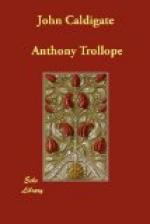But Samuel Bagwax was not a man to be put down by the injustice of lawyers. He knew himself to have been ill-treated. He was confident that no man alive was more competent than himself to form an opinion on such a subject; and he was sure, quite sure,—perhaps a little too sure,—that there had been some dishonesty with that envelope. And thus he became a strong partisan of John Caldigate and of Mrs. John Caldigate. If there had been tampering with that envelope, then the whole thing was fraudulent, false, and the outcome of a base conspiracy. Many points were present to his mind which the lawyers between them would not allow him to explain properly to a jury. When had that die been cut, by which so perfect an impression had been formed? If it could be proved that it had been cut since the date it bore, then of course the envelope would be fraudulent. But it was only in Sydney that this could be ascertained. He was sure that a week’s ordinary use would have made the impression less perfect. Some letters must of course be subjected to new dies, and this letter might in due course have been so subjected. But it was more probable that a new stamp should have been selected for a surreptitious purpose. All this could be ascertained by the book of daily impressions kept in the Sydney post-office;—but there had not been time to get this evidence from Sydney since this question of the impression had been ventilated. It was he who had first given importance to the envelope; and being a resolute and almost heroic man, he was determined that no injustice on the part of a Crown prosecutor, no darkness in a judge’s mind, no want of intelligence in a jury, should rob him of the delight of showing how important to the world was a proper understanding of post-office details. He still thought that that envelope might be made to prove a conspiracy on the part of Crinkett and the others, and he succeeded in getting Sir John Joram to share that belief.
The envelope itself was still preserved among the sacred archives of the trial. That had not been bodily confided to Samuel Bagwax. But various photographs had been made of the document, which no doubt reproduced exactly every letter, every mark, and every line which was to be seen upon it by the closest inspection. There was the direction, which was admitted to be in Caldigate’s handwriting,—the postage-stamp, with its obliterating lines,—and the impression of the Sydney postmark. That was nearly all. The paper of the envelope had no water-marks. Bagwax thought that if he could get hold of the envelope itself something might be done even with that; but here Sir John could not go along with him, as it had been fully acknowledged that the envelope had passed from the possession of Caldigate into the hands of the woman bearing the written address. If anything could be done, it must be done by the postmarks,—and those postmarks Bagwax studied morning, noon, and night.




